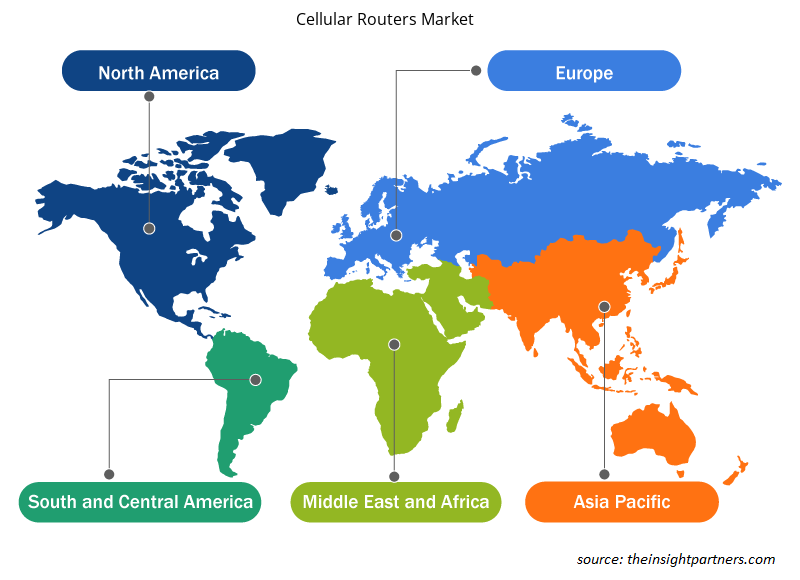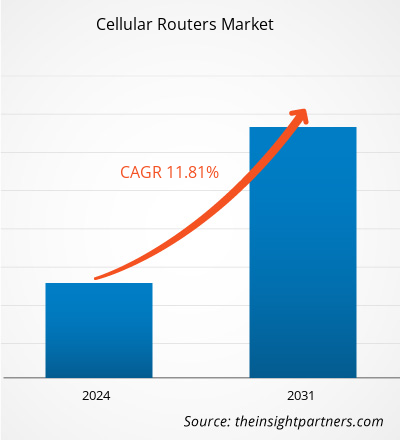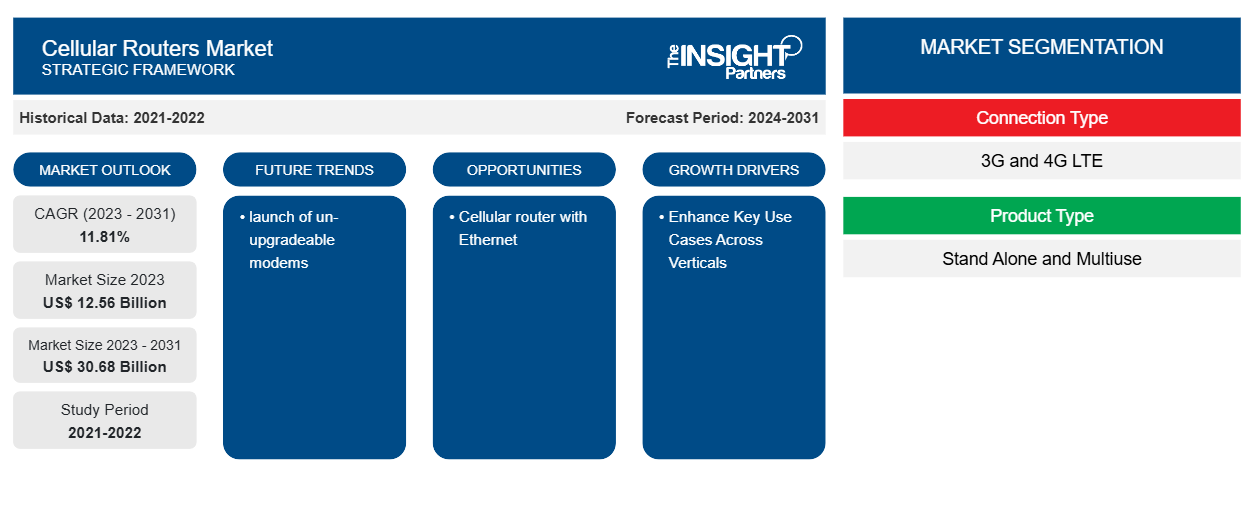Der Markt für Mobilfunkrouter soll von 12,56 Milliarden US-Dollar im Jahr 2023 auf 30,68 Milliarden US-Dollar im Jahr 2031 anwachsen. Der Markt soll zwischen 2023 und 2031 eine durchschnittliche jährliche Wachstumsrate (CAGR) von 11,81 % verzeichnen. Die Einführung nicht aktualisierbarer Modems dürfte ein wichtiger Trend auf dem Markt bleiben.CAGR of 11.81 % in 2023–2031. The launch of un-upgradeable modems is likely to remain a key trend in the market.
Marktanalyse für Mobilfunkrouter
- Mehrere wichtige Aspekte tragen zur schnellen Expansion des Marktes bei. Der weltweite Einsatz von 5G-Mobilfunkmodems wird durch den wachsenden Bedarf an Hochgeschwindigkeitskommunikation mit geringer Latenzzeit aufgrund des weltweiten Wachstums der SG- Technologie vorangetrieben .
- Die Mobilfunkverbindung wird zunehmend in verschiedene Instrumente wie IOT-Geräte, Smart-Home-Geräte und Industrieanlagen integriert und treibt so das Marktwachstum voran.
Marktübersicht für Mobilfunkrouter
- Mobilfunkrouter nutzen Mobilfunktechnologie, um eine Internetverbindung herzustellen. Sie sind eine hervorragende Option für Unternehmen, Haushalte und andere Orte, die keinen Zugang zu kabelgebundenen Internetdiensten wie Kabel oder Glasfaser haben.
- Dies macht Mobilfunkrouter zu einem nützlichen Werkzeug für Organisationen und Einzelpersonen, die an abgelegenen Standorten tätig sind oder auch auf Reisen in Verbindung bleiben müssen.
- Sie verfügen über mehrere wichtige Eigenschaften, die sie zu einer hervorragenden Wahl für mobiles Computing und Kommunikation machen: Konnektivität mit Gigabit-Geschwindigkeit; Mobilfunkrouter bieten schnelle, zuverlässige Verbindungen mit Geschwindigkeiten von bis zu 5G und 4G LTE und ermöglichen so einen schnellen Zugriff auf Streaming-Dienste und Web-Apps.
- Portabilität: Mobilfunkrouter sind leichte, kleine Geräte, die einfach zu transportieren und zu konfigurieren sind.
Passen Sie diesen Bericht Ihren Anforderungen an
Sie erhalten kostenlose Anpassungen an jedem Bericht, einschließlich Teilen dieses Berichts oder einer Analyse auf Länderebene, eines Excel-Datenpakets sowie tolle Angebote und Rabatte für Start-ups und Universitäten.
-
Holen Sie sich die wichtigsten Markttrends aus diesem Bericht.Dieses KOSTENLOSE Beispiel umfasst eine Datenanalyse von Markttrends bis hin zu Schätzungen und Prognosen.
Markttreiber und Chancen für Mobilfunkrouter
Verbessern Sie wichtige Anwendungsfälle in allen Branchen, um den Markt zu begünstigen
- Während WLAN-Netzwerke in vielen Unternehmen zum Standard gehören, erfreuen sich Mobilfunkrouter in zahlreichen Branchen zunehmender Beliebtheit, da sie einen drahtlosen Datenzugriff über Mobilfunknetze ermöglichen.
- WLAN-Router stellen eine drahtlose Netzwerkverbindung zwischen zwei Geräten her, normalerweise über Funkwellen, um Hochgeschwindigkeits-WLAN über kurze Distanzen bereitzustellen. WLAN wird normalerweise verwendet, um über einen drahtlosen Router, der mit einer kabelgebundenen Breitbandverbindung verbunden ist, auf das Internet zuzugreifen.
- Mobilfunkrouter nutzen Mobilfunkmasten, um drahtlose Internetverbindungen über größere Entfernungen bereitzustellen. Sie werden häufig verwendet, um über ein Mobiltelefon oder ein anderes Mobilgerät eine Verbindung zum Internet herzustellen, können aber auch umfangreiche Netzwerke in ländlichen Gebieten unterstützen. Dadurch eignen sie sich gut für mehrere wichtige Anwendungsfälle in verschiedenen Branchen: Einzelhandel, Gesundheitswesen, Transport, Fertigung und andere.
Mobilfunkrouter mit Ethernet
- Viele Router übertragen Internetdaten drahtlos an alle Geräte in ihren WLAN-Netzwerken. Manchmal müssen Sie Ihr Gerät auch über ein Ethernet-Kabel mit dem Router verbinden. Ein Ethernet-Kabel ist ein spezielles Kabel, das eine kabelgebundene Internetverbindung ermöglicht. Vor WLAN war für alle Internetverbindungen ein Ethernet-Kabel erforderlich, das in die Wand gesteckt wurde.wirelessly to all devices on their wifi networks. Other times, you may need to connect your device to the router using an Ethernet wire. An Ethernet cable is a customized cable that Provides a hardwired internet connection. Before wifi, all internet connections required an Ethernet wire hooked into a wall.
- Ethernet-Verbindungen bieten in der Regel eine schnellere und stabilere Internetverbindung als WLAN. Allerdings sind sie unpraktisch, wenn der Benutzer das Gerät physisch bewegen muss. Die meisten Telefone und andere Mobilgeräte verfügen nicht über Ethernet-Kabelverbindungen, sodass Sie zum Anschluss einen Adapter kaufen müssen.wifi. However, they are inconvenient when the user needs to physically move the gadget. Most phones and other mobile devices lack Ethernet cable connections, so you'll need to purchase an adaptor to connect them.
Segmentierungsanalyse des Marktberichts für Mobilfunkrouter
Wichtige Segmente, die zur Ableitung der Marktanalyse für Mobilfunkrouter beigetragen haben, sind Verbindungstyp, Unternehmenstyp und Endbenutzer.
- Nach Verbindungstyp ist der Markt in 3G und 4G LTE segmentiert.LTE.
- Nach Produkttyp ist der Markt in Stand-Alone- und Mehrzweckprodukte segmentiert.
- Nach Anwendung ist der Markt in Einzelhandel und Gewerbe, Wohnen, Industrie und Transport segmentiert.
Marktanteilsanalyse für Mobilfunkrouter nach Geografie
- Der Marktbericht für Mobilfunkrouter umfasst eine detaillierte Analyse von fünf großen geografischen Regionen, die die aktuelle und historische Marktgröße sowie Prognosen für die Jahre 2021 bis 2031 umfasst und Nordamerika, Europa, den asiatisch-pazifischen Raum (APAC), den Nahen Osten und Afrika (MEA) sowie Süd- und Mittelamerika abdeckt.APAC), Middle East and Africa (MEA), and South & Central America.
- Jede Region ist weiter in entsprechende Länder unterteilt. Dieser Bericht bietet Analysen und Prognosen für mehr als 18 Länder und deckt die Marktdynamik von Mobilfunkroutern ab, wie etwa Treiber, Trends und Chancen, die die Märkte auf regionaler Ebene beeinflussen.
- Darüber hinaus umfasst der Bericht eine PEST-Analyse, die die Untersuchung wichtiger Faktoren umfasst, die den Markt für Mobilfunkrouter in diesen Regionen beeinflussen.
Regionale Einblicke in den Markt für Mobilfunkrouter
Die regionalen Trends und Faktoren, die den Markt für Mobilfunkrouter im Prognosezeitraum beeinflussen, wurden von den Analysten von Insight Partners ausführlich erläutert. In diesem Abschnitt werden auch die Marktsegmente und die Geografie für Mobilfunkrouter in Nordamerika, Europa, im asiatisch-pazifischen Raum, im Nahen Osten und Afrika sowie in Süd- und Mittelamerika erörtert.

- Holen Sie sich die regionalspezifischen Daten für den Mobilfunkroutermarkt
Umfang des Marktberichts zu Mobilfunkroutern
| Berichtsattribut | Details |
|---|---|
| Marktgröße im Jahr 2023 | 12,56 Milliarden US-Dollar |
| Marktgröße bis 2031 | 30,68 Milliarden US-Dollar |
| Globale CAGR (2023 - 2031) | 11,81 % |
| Historische Daten | 2021-2022 |
| Prognosezeitraum | 2024–2031 |
| Abgedeckte Segmente |
Nach Verbindungstyp
|
| Abgedeckte Regionen und Länder |
Nordamerika
|
| Marktführer und wichtige Unternehmensprofile |
|
Dichte der Marktteilnehmer für Mobilfunkrouter: Auswirkungen auf die Geschäftsdynamik verstehen
Der Markt für Mobilfunkrouter wächst rasant, angetrieben durch die steigende Nachfrage der Endnutzer aufgrund von Faktoren wie sich entwickelnden Verbraucherpräferenzen, technologischen Fortschritten und einem größeren Bewusstsein für die Vorteile des Produkts. Mit steigender Nachfrage erweitern Unternehmen ihr Angebot, entwickeln Innovationen, um die Bedürfnisse der Verbraucher zu erfüllen, und nutzen neue Trends, was das Marktwachstum weiter ankurbelt.
Die Marktteilnehmerdichte bezieht sich auf die Verteilung von Firmen oder Unternehmen, die in einem bestimmten Markt oder einer bestimmten Branche tätig sind. Sie gibt an, wie viele Wettbewerber (Marktteilnehmer) in einem bestimmten Marktraum im Verhältnis zu seiner Größe oder seinem gesamten Marktwert präsent sind.
Die wichtigsten auf dem Markt für Mobilfunkrouter tätigen Unternehmen sind:
- Cradlepoint, Inc.
- Sierra Wireless, Inc.
- Digi International, Inc.
- Advantech Co. Ltd
- Moxa Inc
- Belden, Inc
Haftungsausschluss : Die oben aufgeführten Unternehmen sind nicht in einer bestimmten Reihenfolge aufgeführt.

- Überblick über die wichtigsten Akteure auf dem Markt für Mobilfunkrouter
Neuigkeiten und aktuelle Entwicklungen zum Mobilfunkroutermarkt
Der Markt für Mobilfunkrouter wird durch die Erhebung qualitativer und quantitativer Daten nach Primär- und Sekundärforschung bewertet, die wichtige Unternehmensveröffentlichungen, Verbandsdaten und Datenbanken umfasst. Nachfolgend sind einige der Entwicklungen auf dem Markt für Mobilfunkrouter aufgeführt:
- D-Link, ein weltweiter Pionier in der Netzwerk- und Verbindungstechnologie, hat den R15 EAGLE PRO AI AX1500 Smart Router vorgestellt. Der brandneue R15 EAGLE PRO AI Router kombiniert die neueste Wi-Fi 6-Technologie mit künstlicher Intelligenz, um eine außergewöhnliche WLAN-Abdeckung und -Geschwindigkeit zu bieten. (Quelle: D-Link, Pressemitteilungen, Dezember 2021)
- Proscend hat einen Outdoor-Mobilfunkrouter auf den Markt gebracht, um die digitale Kluft zu überbrücken. Der Proscend Outdoor 4G LTE Cellular Router M366 ist für kostengünstige, einfach zu implementierende und flexible Fixed Wireless Access (FWA)-Lösungen konzipiert. Mit der ausgereiften 4G-Netzabdeckung kommt Proscend M366 nicht nur Haushalten in nicht versorgten und unterversorgten Gebieten zugute, in denen keine drahtgebundene Infrastruktur erreichbar ist. (Quelle: Proscend, Pressemitteilungen, April 2022)
Marktbericht zu Mobilfunkroutern – Abdeckung und Ergebnisse
Der Bericht „Marktgröße und Prognose für Mobilfunkrouter (2021–2031)“ bietet eine detaillierte Analyse des Marktes, die die folgenden Bereiche abdeckt:
- Marktgröße und Prognose für Mobilfunkrouter auf globaler, regionaler und Länderebene für alle wichtigen Marktsegmente, die im Rahmen des Projekts abgedeckt sind
- Markttrends für Mobilfunkrouter sowie Marktdynamiken wie Treiber, Einschränkungen und wichtige Chancen
- Detaillierte PEST/Porters Five Forces- und SWOT-Analyse
- Marktanalyse für Mobilfunkrouter mit wichtigen Markttrends, globalen und regionalen Rahmenbedingungen, wichtigen Akteuren, Vorschriften und aktuellen Marktentwicklungen
- Branchenlandschaft und Wettbewerbsanalyse, die die Marktkonzentration, Heatmap-Analyse, prominente Akteure und aktuelle Entwicklungen auf dem Markt für Mobilfunkrouter umfasst
- Detaillierte Firmenprofile
- Historische Analyse (2 Jahre), Basisjahr, Prognose (7 Jahre) mit CAGR
- PEST- und SWOT-Analyse
- Marktgröße Wert/Volumen – Global, Regional, Land
- Branchen- und Wettbewerbslandschaft
- Excel-Datensatz
Aktuelle Berichte
Verwandte Berichte
Erfahrungsberichte
Grund zum Kauf
- Fundierte Entscheidungsfindung
- Marktdynamik verstehen
- Wettbewerbsanalyse
- Kundeneinblicke
- Marktprognosen
- Risikominimierung
- Strategische Planung
- Investitionsbegründung
- Identifizierung neuer Märkte
- Verbesserung von Marketingstrategien
- Steigerung der Betriebseffizienz
- Anpassung an regulatorische Trends























 Kostenlose Probe anfordern für - Markt für Mobilfunkrouter
Kostenlose Probe anfordern für - Markt für Mobilfunkrouter